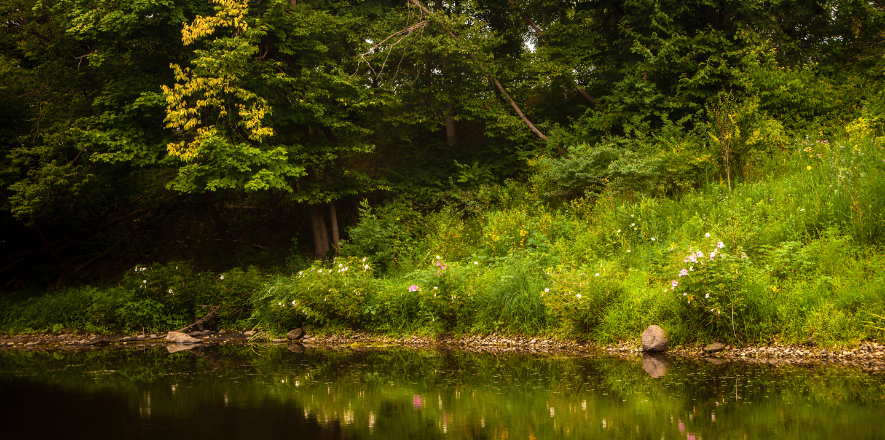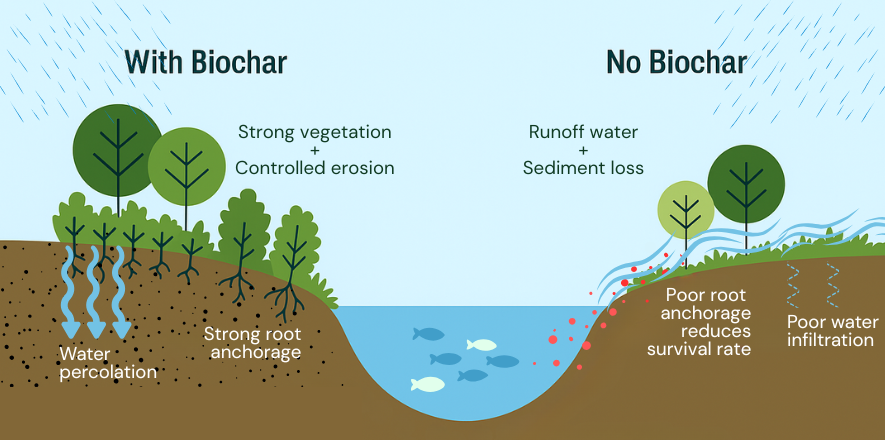Biochar: A Nature-Based Solution to Reduce Shoreline Erosion

Coastal and riparian erosion represents one of the most visible consequences of climate change and land-use alteration. The Intergovernmental Panel on Climate Change (IPCC, 2019) identifies shoreline degradation as a growing global concern linked to sea-level rise, storm surges, changing precipitation patterns, and human activities. Whether you live in an urban or rural area, erosion is something you can see with your own eyes.
Addressing this challenge has proven difficult for municipalities and governments alike. Traditional erosion control relies mainly on structural interventions that often transfer, rather than solve, the problem (IPCC, 2019) such as seawalls and riprap. These “hard” engineering solutions can be effective in the short term but are typically costly, rigid, and environmentally disruptive.
Fortunately, there’s a nature-based alternative that is gaining traction because it’s more affordable, flexible, and environmentally friendly: revegetated shorelines using biochar as a soil amendment.
What Is Biochar and How Does It Work?
Biochar is a carbon-rich, porous material produced through the carbonization of biomass residues. A well-produced biochar such as the one produced with Airex Energy’s Carbon FX-HT technology has a high surface area, stable carbon content and excellent water retention capacity.
Its versatile properties have shown strong results in strengthening soils, increasing root development, improving texture and aeration, and stimulating microbial activity (Mahmoud et al., 2024; Zhang et al., 2023).
When applied to coastal or riverbank soils, biochar improves aggregate stability, increases cohesive strength, and enhances infiltration capacity, thereby reducing runoff and sediment loss. Its unique physical and chemical characteristics also help capture contaminants, protecting lakes, rivers, and seas from pollution.
By helping stabilize soils, foster vegetation growth, Biochar is at the core of an eco-friendly solution to create a more resilient shoreline system. Moreover, its long-term carbon stability contributes to climate mitigation through carbon sequestration (IPCC, 2019).

Why Biochar Is Good for Shorelines
Stronger soil structure:
Biochar increases aggregate stability and resistance to detachment during hydraulic stress.
Better water retention:
By improving infiltration, biochar reduces runoff that typically carries sediment into waterways.
Superior vegetation support:
Biochar fosters healthier root systems, which enhance soil cohesion and reduce erosion (Sommers et al., 2024).
Effective sediment trapping:
Biochar-amended buffer zones can trap suspended sediments and nutrients, reducing downstream sedimentation.
Longer and stronger resilience:
Biochar’s durability ensures long-lasting benefits, unlike organic amendments that degrade rapidly (IPCC, 2019).
Evidence from Research
Scientific studies increasingly confirm biochar’s effectiveness in stabilizing eroding landscapes.
- Zhang et al. (2023) demonstrated improved slope stability and reduced erosion rates in biochar-amended soils under simulated rainfall.
- Mahmoud et al. (2024) found that biochar-enhanced soils in riparian systems improved root strength and sediment retention compared to control sites.
- Sommers et al. (2024) explored biochar’s role in coastal wetland resilience, showing that amendments increased vegetation cover and soil shear strength.
- Li et al. (2023) highlighted, in a comprehensive review, biochar’s potential in nature-based shoreline protection, particularly when integrated with vegetation and soft-engineering approaches.
In a rainfall-simulation experiment on a highly weathered soil, applying 5% biochar reduced soil loss by 64% relative to the control (Jien & Wang, 2013). Under seal-formation conditions, a 2% biochar addition in loamy sand lowered soil loss by a factor of 3.6, equivalent to an approximate 72% reduction (Verheijen et al., 2016). Meta-analyses covering dozens of studies report context-dependent outcomes but confirm significant mean reductions (≈25–30% on average) across soils, biochar types, and experimental designs (Gholamhmadi et al., 2023; related syntheses).
Overall, the evidence shows that biochar not only helps control erosion but also strengthens ecosystems by enhancing soil fertility, biodiversity, and carbon storage.
Practical Implementation Considerations
Successful application of biochar in shoreline restoration requires careful design.
- Feedstock and production: Biochar characteristics depend on feedstock type and pyrolysis temperature, which influence its quality. With Airex Energy’s technology, we can guarantee quality and homogeneity of the biochar.
- Application rate: Field trials generally recommend 2–10% (by volume) biochar integration into shoreline soils (Zhang et al., 2023).
- Integration with vegetation: Pairing biochar with native or salt-tolerant plants improves long-term stabilization (Mahmoud et al., 2024).
- Site conditions: Factors such as hydrodynamics, salinity, and slope angle must be evaluated before application.
Because biochar improves soil structure, supports vegetation, and retains sediments, it is considered as a nature-based alternative to conventional, rigid infrastructure.
As the world looks for sustainable, cost-effective solutions to shoreline degradation, biochar stands out as a multifunctional tool; combining erosion control, ecosystem restoration, and durable carbon sequestration in one integrated strategy.
References
Intergovernmental Panel on Climate Change (IPCC). (2019). Special Report on Climate Change and Land. Chapter 4: Land Degradation. Retrieved from https://www.ipcc.ch/srccl/chapter/chapter-4/
Li, X., Chen, Y., & Zhang, L. (2023). Mitigation measures to control erosion in river banks and shorelines: A review of biochar applications. Science of the Total Environment, 869, 162436. https://www.sciencedirect.com/science/article/pii/S0048969723004758
Mahmoud, H., Tarek, A., & Gomez, P. (2024). Biochar applications in riparian and wetland restoration for erosion control. Frontiers in Environmental Science, 12, 1373287. https://www.frontiersin.org/journals/environmental-science/articles/10.3389/fenvs.2024.1373287/full
Sommers, D., Nguyen, L., & Rojas, E. (2024). The role of biochar in enhancing coastal resilience and shoreline stabilization. AGU Fall Meeting 2024 Abstracts, EP43B-1287. https://ui.adsabs.harvard.edu/abs/2024AGUFMEP43B1287A/abstract
Zhang, Q., Li, P., & Wu, J. (2023). Biochar-amended soils for slope stability and erosion resistance. Land, 12(12), 2111. https://www.mdpi.com/2073-445X/12/12/2111
Jien, S.-H., & Wang, C.-S. (2013). Effects of biochar on soil properties and erosion potential in a highly weathered soil. Catena, 110, 225–233.
Verheijen, F. G. A., et al. (2016). Biochar effects on soil water infiltration and erosion under seal formation conditions: Rainfall simulation experiment. Journal of Soils and Sediments.
Gholamhmadi, B., Jeffery, S., González-Pelayo, O., et al. (2023). Biochar impacts on runoff and soil erosion by water: A systematic global-scale meta-analysis. Science of the Total Environment, 871, 161860.
Monir Hossain et al (2025), Increased erosion in biochar-amended soil: importance of integrating erosion control blankets and vegetation. https://www.sciencedirect.com/science/article/pii/S2949929125000014?via%3Dihub
Head Office
2500 Bernard-Lefebvre Street
Laval, Québec, Canada, H7C 0A5
450.328.3864
